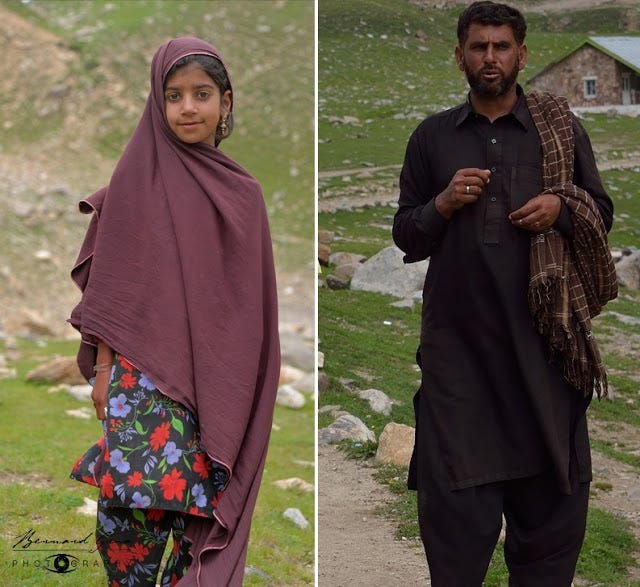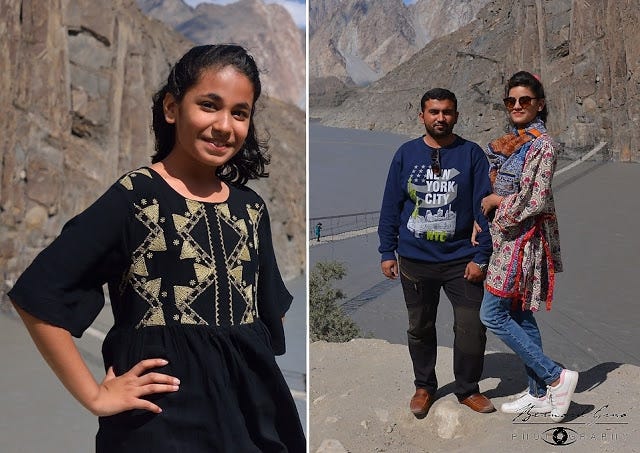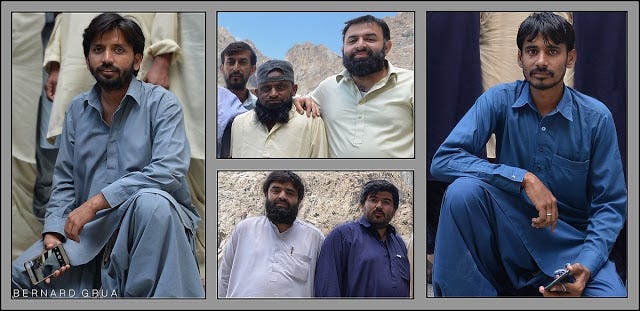Portraits, Wakhi in relation with other people of their areas

The origin of the less than 100,000 Wakhi people is Wakhan corridor from where they emigrated but also where they, sometimes, partly came back. Their movements are explained by religion changes (Zoroastrian, Buddhism, Islam), trade, pastoralism, wars (Chinese, Tibetan, Arabs…), oppressions from local rulers (Wakhan Mirs), or more distant ones (Badakhshan Emirs, Bukhara Emirs, Yarkand Khan…), Afghanistan’s harsh annexion with the Pashtun Abdur Raman, Russian and Chinese communism, etc.
Wakhi can, now, be found in the highest parts of the three largest watersheds of Central Asia (Amu Darya, Tarim, Indus). They live between 2,300 m and 4,000 m. They share some parts of their traditional areas, with small groups of other people, mostly Tajik Pamiri and Burushaski (with whom they belong to the same Ismaelian faith), Kirghiz and Uigurs (Sunni faith). Closing of the borders, starting end of XIX century fragmented Wakhi people into different isolates. The heaviest impacts on families were likely in Wakhan corridor were Panj River (Amu Darya) suddenly materialized two separate entities between Soviet Tajikistan and Afghanistan, building an actual and durable “Berlin wall”.
Except for similar geographical constrains, their major link between each other is the Aga Khan, their common spiritual leader, and the remarkable work performed by his foundation. It should also be mentioned the fact that Tajik cell phone network can transmit in Afghan Wakhan allowing relatives talking over the river. Since 1974 and the annexation of Hunza kingdom by Pakistan, Pakistani Wakhi are a very small minority in a country having more than 200 million of citizens. As other Shia groups, they are subject to a Sunni-based legal and judicial system and a Sunni-dominated admnistration.
Here below will be showed some of other people from their different countries or with whom they live. Unfortunately no visits as of today, then no pictures, were done in China. Moreover the quasi-ethnocide handled by Beijing in historical Eastern Turkistan does not permit foreigners to stop between Kunjerab Pass (Pakistan/China border) and Tashkurgan city, an area of local Wakhi people.
Although it may lead to too long developments, it can be observed, on the following pictures that Wakhi, as other Pamiri people, look very much like European people and differ from other Asian ones.
Wakhi of Gojal (Upper Hunza, Pakistan)


Wakhi of Tajik Wakhan corridor

Below, the pictures of other Wakhi children taken just on the opposite Afghan bank of the Panj show they are not only separated by a river but also they belong, now, to two different worlds.
Wakhi of Afghan Wakhan corridor


*Kiamadin and Shikriya are two grand children of Pir Shah Ismaily, the religious leader of Afghan Wakhan.
Pamiri of Tajikistan


Unsurprisingly, five years after these Tajik Pamir pictures were taken, Odinasho Sharopov joined the AGK Foundation summer class for future leaders held in Pakistan with other young Ismaili people from different countries. He had, then, the opportunity to visit Gojal and to understand that the Ismaili Pamiri community is an international one.
Kirghiz, Tajikistan, Afghanistan, China


Kirghiz presented above were photographed in their summer jailoo(s) around Murghab, in Tajik Pamir.
Since the middle of XXth century, in the severe conditions of « closed frontiers » (Nazif Shahrani) The Kirghiz from Afghan Pamir, « forgotten on the roof of the world » (Matthieu Paley), developped an interdependant economy with Wakhi from Afghan Wakhan in place of China (Kashgar and Yarkand bazars) or Russian Turkistan. They nevertheless still organise regular caravans to Chapursan Valley at summer end. There, at Baba Ghundi, they barter their animals against other Pakistani and Chinese goods with people from Zoodkhun as explained, in 2018, by Gohar Abbas (“Heaven and hell”) and as told, in 2003, by Mareil Paley’s humour (Pamir p.23) :
Our Pakistani friend Alam Jan (Dario) invites us into the sheperd house (at Baba Ghundi) of his father. He prepares tea. He does not take care of us as much as he does usually. The annual visit of the two crazy angrez (foreigners) does not have the same attraction power. « Your are my sister. You are my brother » — that’s what he always says. But today, Kirghiz people are here, there is animation… We can get fresh butter from Pamir!
Oustanding Matthieu Paley’s pictures can be watched here: Kirghiz and Wakhi, in Little Pamir (Afghanistan). At the end of summer 2016, Dinara Kanybek Kyzy, a young Kirghiz anthropologist (from Kirghizstan) joined a humanitarian expedition from her government. She made an interesting and informative paper about this experience. It is in Russian, on Open Asia, and also in French, on Novastan.
Gujars of Kaghan Valley, Pakistan

Punjabi (Lahore, Islamabad…) from Pakistan

For understandable reasons neither fully veiled women tourists have been photographed nor the permission has been asked to their husbands for making such a picture. Some are in a complete black color, including gloves, though they are in a limited number. In Hunza, they look like «out of context». They are Sunni fundamentalists from other regions of Pakistan. Regarding the attire, it is interesting to remember that seapoosh (black worn) is the local and historical definition of kafir (infidels)… See: “How past and present religions built a tradition palimpsest in a high valley of northern Pakistan”.
Pathans (Pashtuns) from Pakistan

While most of Pakistani Wakhi live in Gojal (Upper Hunza) from Gulmit to Chinese border, there are around 1,400 Wakhi living, more south, in Chitral district. They came from Afghanistan mostly via Broghil Pass at different periods of time. Next to Chitral district is the Swat region connecting with Peshawar. Swat, inhabited by Pathans, came under Taliban control, where they still present a serious threat. There, 120,000 young girls have been prohibited to attend schools. In the opposite, girls education is one of the top priorities of Wakhi, contributing to explain why Wakhi young people have one of the highest world literacy level.
None of the three religions (Zoroastrianism, Buddhism, Islam), as they were applied by Wakhi people, prevented ladies to walk with open faces in front of men (Odinamamadi Mirzo).
Balochi from Pakistan

Here, this group of Balochi men was travelling and making selfies at Attabad Lake, Hunza. In their region, too, thousands of young girls can’t attend schools. They have few common features with Wakhi people.
Know more about Wakhi people culture with Pamir Trails
Chapursan with Shimshal Valley are the two Wakhi highest settlements in northern Pakistan. Pamir Trails based in Zood Khun, Chapursan Valley, can propose you cultural tours in these valleys but also in Tajik and Afghan Wakhan inhabited by Wakhi people, who speak the same language and share family connections.

Note:
- This article is in extract of a paper published by Bernard Grua on his blog: “At the knot of past empires: Zoodkhun, a Wakhi village in the high northern mountains of Pakistan”
- All pictures are © Bernard Grua and cannot be used without his written approval.
You liked this article? Save it on Pinterest

List of all stories about the same topic, on Medium, by the author
- How past and present religions built a tradition palimpsest in a high valley of northern Pakistan
- Wakhi mountain houses of Zoodkhun in Chapursan Valley, northern Pakistan
- Portraits, Wakhi in relation with other people of their areas
- Wakhi people and Pamir life ex-libris
- What to see and what to do in a short period of time in Hunza
- The Great Game: Anglo-Russian encounter at the borders of Pamir, Hindu Kush and Karakoram
- Zoodkhun Village in Chapursan Valley preserves a scenic and authentic mountain oasis landscape
- Zoodkhun, Chapursan Valley, a life environment determined by altitude and remotness
- Chapursan Valley, where Zoodkhun nights unveil the universe
- What place for Zoodkhun into the global world?
- Karakoram Highway, a prototype of the new Silk Roads?
- Some reflections about the development of a responsible and community based tourism in Hunza Valley
This article on Twitter
This article presented as a Twitter carousel on Google

Where to stay in Chapursan Valley
Pamir Serai guest houses are the traditional homestay of Zoodkhun and Baba Ghundi for external visitors. They are run by the internationaly famous Alam Jan Dario’s family.
Sky Bridge Motel & Resorts opened in 2018. It is run by Fahim U. Baig in Zoodkhun.
Hilltop Guest House is run by Haider Badakhshoni in Reshit.
